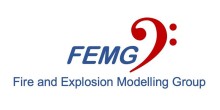

Liquid hydrogen safety
Detailed analysis about safety issues related to liquid hydrogen applications in transport systems and the built environment, working closely with international energy companies.
Safety of cryogenic liquid hydrogen
Hydrogen is one of a handful of new, low carbon solutions that will be critical for the transition to net zero. The upscaling of production and applications entails that hydrogen is likely to be stored in liquid phase (LH2) at cryogenic conditions to increase its energy density.
Widespread LH2 use as an alternative fuel will require significant infrastructure upgrades to accommodate increased bulk transport, storage, and delivery. However, current LH2 bulk storage separation distances are based on subjective expert recommendations rather than experimental observations or physical models. Experimental studies of large-scale LH2 release are challenging and costly. The existing large-scale tests are scarce and numerical studies are a viable option to investigate the existing knowledge gaps.
LH2 jets

Controlled or accidental releases of LH2 for hydrogen refueling infrastructure would result in high momentum two-phase jets or formation of liquid pools depending on release conditions.
The in-house OpenFOAM has been modified to simulate the jet dispersion, pool evaporation and the subsequent atmospheric dispersion from cryogenic liquid hydrogen releases.
Catastrophic releases
The abrupt depressurisation of large amount of LH2 would lead to the formation of a LH2 pool, accompanying a spontaneous flash evaporation. The LH2 in the pool is heated via the heat transfer from the solid ground/walls, ambient air and the sun radiation. In the initial stage of the evaporation process, the conduction heat transfer via the ground is the major contribution due to the very large temperature difference, which results in fast vaporisation due to the violent boiling.

The evaporated gaseous hydrogen is dispersed in the ambient air, forming a dense cloud. The hydrogen temperature is lower than the liquidification/solidification temperature of the air components, causing phase changes. The dispersion leads to a formation of a flammable/explosive cloud, which is a safety issue to the public. The accurate prediction of the atmospheric hydrogen distribution is an important task of accurate hazard assessments of storage systems.
Numerical prediction of the atmospheric dispersion requires the determination of the pool size and evaporation rate being inlet conditions. The inlet conditions are closely related to the release modes. The catastrophic failure of a storage tank is the most dangerous release scenarios, which causes an instantaneous release of LH2. Moreover, to retard the spread of LH2 and to limit the vaporisation rate, a detention pit is intended to be used to minimise the size of the flammable vapour cloud which must be dispersed to nonflammable concentrations. hyFOAM has been modified to address the atmospheric dispersion of instantaneously release LH2. Consideration has been given to the scenarios with/without retention pits.
LH2 jet fires
Controlled or accidental releases of liquid hydrogen (LH2) for hydrogen refuelling infrastructure would result in high momentum two-phase jets, or formation of liquid pools depending on release conditions. Both release scenarios lead to a flammable/explosive cloud, posing a safety issue to the public. The in-house HyFOAM has been modified to conduct exploratory study about the safety zone resulting from cryogenic hydrogen releases related to LH2 storage and refueling at airports using an in-house CFD code, developed for gaseous cryogenic hydrogen releases and subsequent atmospheric dispersion and ignition on the platform of OpenFOAM V8.0.
Numerical simulations of dispersion and subsequent ignition of LH2 release scenarios with respect to different release orientations, release rates, release temperatures and weather conditions were performed. Both hydrogen concentration and temperature fields were predicted, and the boundary of zones within the flammability limit was also defined.
Vapour cloud explosions
LH2 is below the freezing temperature of oxygen (-218.8 0C). It evaporates with a volume expansion of 1:848, posing significant risk as a flammable gas. Delayed ignition of released liquid hydrogen would result in vapour cloud explosions (VCE).
The in-house HyFOAM solver has been modified to simulate VCE. The current version of the solver neglects the flashing process by assuming that the temperature of the stored LH2 is equal to the boiling point at the atmospheric condition. Numerical simulations of dispersion and subsequent ignition of LH2 release scenarios with respect to different release orientations, release rates, release temperatures and weather conditions have been performed.
Publications
Ren, Z.X., Giannissi, S., Venetsanos, A.G., Friedrich, A., Kuznetsov, M., Jordan, T., Wen, J.X. (2022), The evolution and structure of ignited high-pressure cryogenic hydrogen jets, Int. J. Hydrogen Energy (In press) https://doi.org/10.1016/j.ijhydene.2022.06.230
Ren, Zhaoxin and Wen, Jennifer X. (2020) Numerical characterization of under-expanded cryogenic hydrogen gas jets. AIP Advances, 10 (9). 095303. doi:10.1063/5.0020826
Baopeng Xu and J X Wen, Exploratory study of liquid hydrogen hazards, submitted to Int Conference on Hydrogen Safety, Quebec, Canada, 2023.
Join us
If you are interested in undertaking a project with us then please contact us to discuss options.

Professor Jennifer Wen
Head of Fire and Explosion Modelling Group